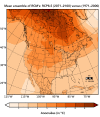Climate change and infectious diseases: What can we expect?
- PMID: 31285696
- PMCID: PMC6587697
- DOI: 10.14745/ccdr.v45i04a01
Climate change and infectious diseases: What can we expect?
Abstract
Global climate change, driven by anthropogenic greenhouse gas emissions, is being particularly felt in Canada, with warming generally greater than in the rest of the world. Continued warming will be accompanied by changes in precipitation, which will vary across the country and seasons, and by increasing climate variability and extreme weather events. Climate change will likely drive the emergence of infectious diseases in Canada by northward spread from the United States and introduction from elsewhere in the world via air and sea transport. Diseases endemic to Canada are also likely to re-emerge. This special issue describes key infectious disease risks associated with climate change. These include emergence of tick-borne diseases in addition to Lyme disease, the possible introduction of exotic mosquito-borne diseases such as malaria and dengue, more epidemics of Canada-endemic vector-borne diseases such as West Nile virus, and increased incidence of foodborne illnesses. Risk is likely to be compounded by an aging population affected by chronic diseases, which results in greater sensitivity to infectious diseases. Identifying emerging disease risks is essential to assess our vulnerability, and a starting point to identify where public health effort is required to reduce the vulnerability and exposure of the Canadian population.
Keywords: Lyme disease; chronic disease; climate change; foodborne; mosquito-borne diseases; precipitation; temperature; vector-borne disease.
Conflict of interest statement
Conflict of interest: None.
Figures




References
-
- National Centers for Environmental information. Climate at a glance: global time series. Asheville (NC): NOAA; 2018 Sep. https://www.ncdc.noaa.gov/cag/global/time-series

